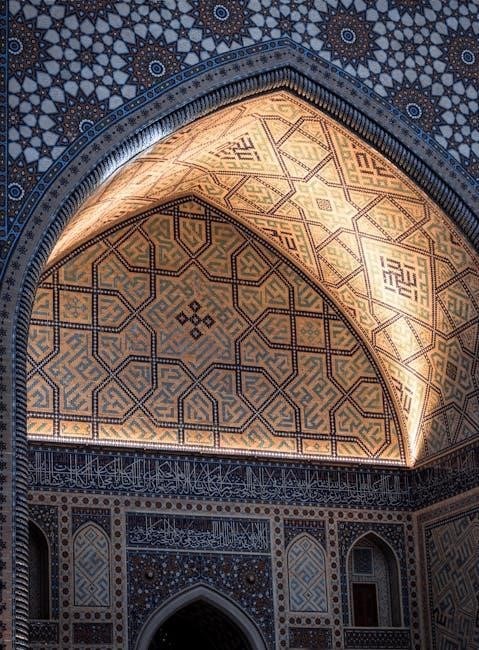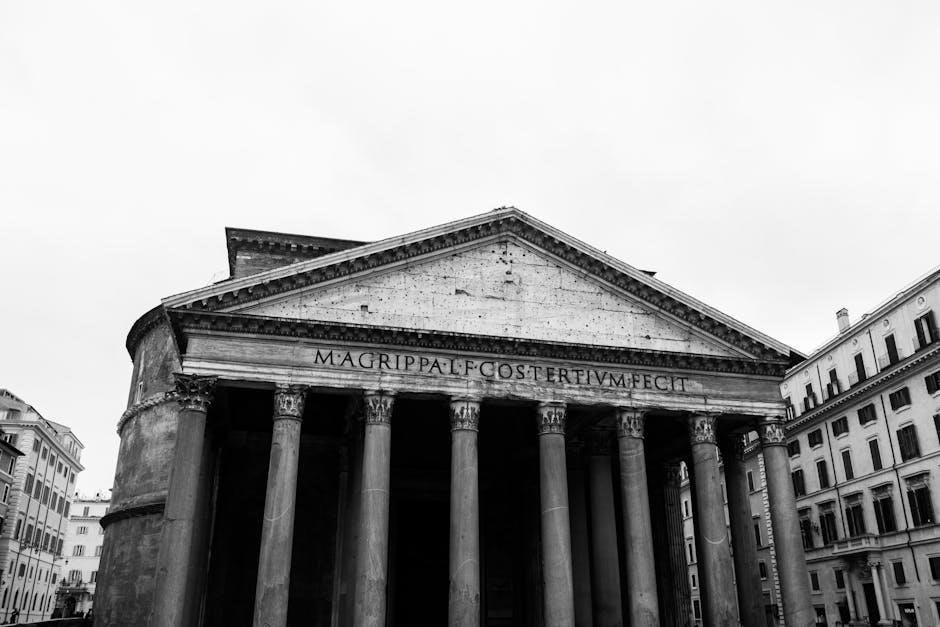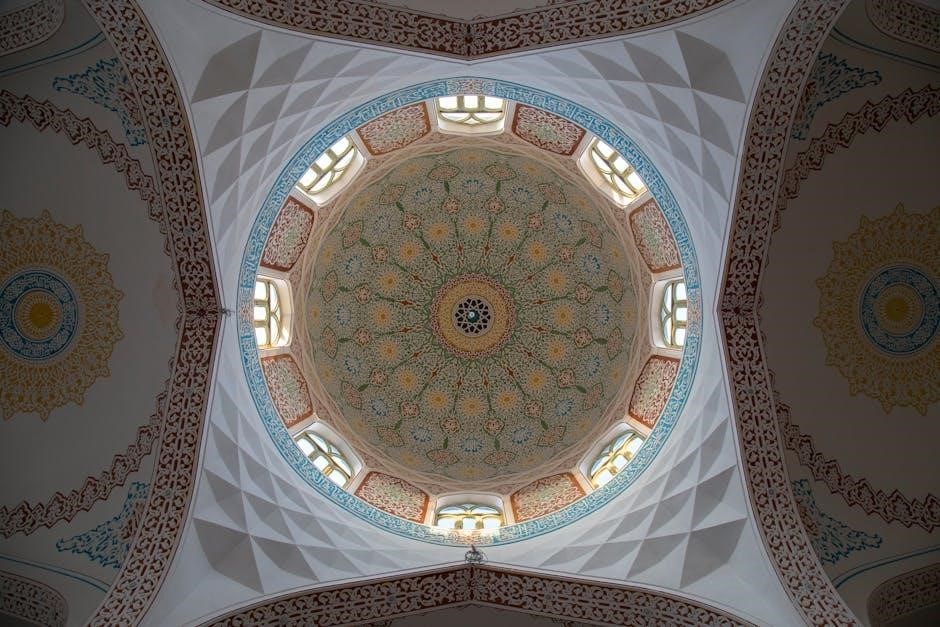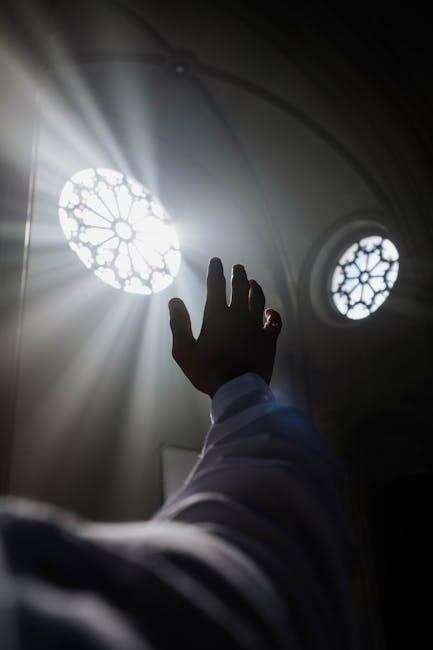Sacred geometry explores the divine proportions and patterns underlying existence‚ bridging spirituality and mathematics. It reveals symbolic meanings in shapes‚ offering insights into the universe’s structure and humanity’s connection to the cosmic order.
1.1 Definition and Overview
Sacred geometry is the study of geometric patterns and shapes believed to represent divine laws and universal principles. It explores how these patterns underlie all of existence‚ from the molecular to the cosmic level. Rooted in the idea that geometry is a language of the universe‚ sacred geometry reveals symbolic meanings in shapes like the Sri Yantra‚ mandalas‚ and the Flower of Life. These patterns are thought to embody spiritual truths and the harmonic proportions of creation. By examining these geometric configurations‚ practitioners seek to understand the interconnectedness of all things and the sacred structure of reality. Sacred geometry bridges spirituality and mathematics‚ offering insights into the universe’s design and humanity’s place within it. It is both a philosophical framework and a practical tool for spiritual growth and self-discovery.
1.2 Historical Background
Sacred geometry has ancient roots‚ with evidence of its principles found in the art‚ architecture‚ and spiritual practices of early civilizations. Cultures such as the Egyptians‚ Greeks‚ and Indians recognized geometric patterns as reflections of divine order. The Pythagoreans‚ for instance‚ studied ratios and proportions‚ believing they held the secrets of the universe. Religious and mystical traditions‚ including Buddhism‚ Hinduism‚ and Christianity‚ incorporated sacred geometry into their symbols and structures. Early philosophers and mathematicians laid the groundwork for understanding these patterns as representations of cosmic harmony. Over time‚ sacred geometry evolved‚ blending spiritual and mathematical insights to create a timeless framework for exploring the nature of existence. Its historical roots emphasize its role as a universal language‚ connecting humanity to the divine and the natural world.
1.3 Spiritual Significance
Sacred geometry is deeply intertwined with spirituality‚ serving as a bridge between the physical and metaphysical realms. Its patterns and symbols‚ such as the Sri Yantra and Mandalas‚ are believed to embody divine energy and cosmic order. These geometric forms are often used in meditation and rituals to connect individuals with the universe’s harmony. The spiritual significance lies in their ability to represent the infinite and the interconnectedness of all things. Sacred geometry is also seen as a tool for self-discovery‚ revealing truths about human consciousness and the nature of existence. Its universal symbols transcend cultures‚ offering a visual language of the divine. This spiritual dimension has made sacred geometry a cornerstone of various religious and philosophical traditions‚ guiding seekers toward enlightenment and unity with the cosmos. Its timeless appeal continues to inspire those exploring the mysteries of the soul and the universe.
Key Principles of Sacred Geometry
Sacred geometry is rooted in the belief that the universe is governed by divine proportions and patterns. These principles are universal‚ reflecting the harmony and order of creation. They are expressed through sacred symbols and mathematical precision‚ embodying the essence of existence. The study of these principles reveals the interconnectedness of all things‚ offering insights into the nature of reality and consciousness. Sacred geometry provides a framework for understanding the spiritual and physical worlds‚ bridging the gap between the finite and the infinite. Its principles are timeless‚ guiding humanity toward enlightenment and unity with the cosmos. These divine laws are the foundation of sacred geometry‚ inspiring awe and deeper understanding. The principles are universal‚ transcending cultures and eras‚ and continue to influence art‚ science‚ and spirituality. They are a testament to the inherent order of the universe‚ a reflection of its sacred design. Through sacred geometry‚ one can explore the mysteries of existence and the divine blueprint of creation. The principles are a gateway to higher consciousness‚ offering a visual and mathematical language of the spiritual realm. By studying these principles‚ individuals can gain profound insights into the nature of reality and their place within it. Sacred geometry is not just a discipline but a spiritual journey into the heart of existence. Its principles are a reminder of the beauty and harmony that underlie all of life. The study of sacred geometry invites us to see the world through the lens of the divine‚ revealing the hidden patterns that shape our universe. These principles are a source of inspiration‚ guiding us toward a deeper understanding of ourselves and the world we inhabit. Through sacred geometry‚ we can experience the unity and interconnectedness of all things‚ transcending the boundaries of the material world. The principles of sacred geometry are a powerful tool for personal growth‚ spiritual evolution‚ and the pursuit of wisdom. They offer a path to enlightenment‚ revealing the sacred truths that lie at the core of existence. The principles are a testament to the divine order of the universe‚ a reminder of the beauty and harmony that underlie all of life.
2.1 The Source of Sacred Geometry
The source of sacred geometry lies in the universal geometric laws that govern the structure of the universe. These laws are believed to be divine‚ reflecting the inherent order and harmony of creation. Sacred geometry is rooted in the idea that the universe is constructed from timeless‚ unchanging mathematical principles. These principles are expressed through sacred symbols and patterns‚ such as the Flower of Life and the Platonic Solids‚ which are thought to represent the fundamental building blocks of existence. The source of these geometric laws is often attributed to the divine or the cosmos itself‚ transcending human culture and time. Sacred geometry is seen as a bridge between the physical and spiritual realms‚ offering insights into the nature of reality and the interconnectedness of all things. Its principles are universal‚ appearing in the art‚ architecture‚ and spiritual practices of diverse cultures throughout history.

2.2 Core Principles and Patterns
The core principles of sacred geometry revolve around universal patterns and mathematical ratios that underpin all existence. These principles include the concept of unity‚ where all things are interconnected‚ and the idea of divine proportion‚ often expressed through the golden ratio. Sacred patterns such as the Flower of Life‚ Metatron’s Cube‚ and the Sri Yantra are believed to represent the blueprint of the universe. These patterns are thought to contain the fundamental information of creation‚ reflecting the harmony and balance inherent in nature. The repetition of these geometric forms across cultures highlights their timeless and universal significance. By studying these core principles and patterns‚ individuals can gain a deeper understanding of the sacred structure of the cosmos and its reflection in human consciousness and art. This knowledge is considered a gateway to spiritual enlightenment and self-discovery.
2.3 Universal Mathematical Symbols
Universal mathematical symbols in sacred geometry represent the fundamental language of creation‚ encoding spiritual and cosmic truths. These symbols‚ such as the Sri Yantra‚ Platonic solids‚ and the Flower of Life‚ embody divine proportions and fractal patterns. They reflect the unity and interconnectedness of all existence‚ transcending cultural boundaries. The golden ratio‚ a cornerstone of sacred geometry‚ is often symbolized in these forms‚ representing harmony and balance. These symbols are believed to hold the power to awaken higher states of consciousness and connect individuals to the universe’s underlying structure. Their mathematical precision and spiritual significance make them tools for meditation‚ art‚ and architectural design‚ bridging the physical and metaphysical realms. Through these symbols‚ sacred geometry reveals the hidden order of creation‚ inspiring awe and deeper understanding of the divine blueprint.

Sacred Symbols and Their Meanings
Sacred symbols like the Sri Yantra‚ Mandalas‚ Flower of Life‚ and Platonic Solids hold profound spiritual significance‚ representing universal patterns and divine order in creation.
3.1 The Sri Yantra and Mandalas
The Sri Yantra and Mandalas are profound symbols in sacred geometry‚ embodying cosmic harmony and spiritual unity. The Sri Yantra‚ a intricate geometric diagram‚ consists of nine overlapping triangles forming a central bindu‚ symbolizing the unity of masculine and feminine energies. Mandalas‚ meaning “circles” in Sanskrit‚ are universal symbols found in various cultures‚ representing wholeness and the interconnectedness of existence. Both are used in meditation and rituals to connect with the divine‚ reflecting the universe’s order and balance. Their intricate patterns and symmetries are believed to hold spiritual power‚ guiding practitioners toward enlightenment and inner peace. These sacred forms are deeply rooted in Hindu and Buddhist traditions‚ offering visual representations of complex philosophical concepts. Their study and contemplation are essential in understanding sacred geometry’s spiritual dimensions and universal truths.
3.2 The Flower of Life
The Flower of Life is a sacred geometric pattern composed of overlapping circles‚ creating a hexagonal grid of interconnected forms. Found in ancient cultures worldwide‚ it symbolizes the fundamental forms of space and time. This pattern is believed to represent the unity and diversity of life‚ containing within it the seeds of all creation. The Flower of Life is a visual depiction of the connections between all living beings and the universe‚ embodying the principles of oneness and infinity. Its intricate design is thought to hold the secrets of the cosmos‚ making it a powerful tool for spiritual growth and healing. By studying this symbol‚ one can gain insights into the nature of reality and the interconnectedness of all existence.

3.3 The Platonic Solids
The Platonic solids are a set of five three-dimensional shapes of great spiritual and mathematical significance in sacred geometry. These include the tetrahedron‚ cube‚ octahedron‚ dodecahedron‚ and icosahedron. Each solid is composed of identical‚ regular polygons‚ symbolizing harmony and divine order. Sacred geometers view these shapes as representations of the fundamental elements of the universe—earth‚ air‚ fire‚ water‚ and ether. The tetrahedron‚ for instance‚ is often linked to fire and transformation‚ while the cube represents stability and structure. These solids are believed to embody the principles of unity and balance‚ reflecting the underlying order of creation. Their study is considered a gateway to understanding the sacred blueprint of the cosmos and humanity’s place within it. They are deeply revered in various spiritual traditions for their symbolic and metaphysical properties.
3.4 The Six-Pointed Star
The six-pointed star‚ a prominent symbol in sacred geometry‚ is formed by the intersection of two triangles: one pointing upward (representing masculine energy) and the other downward (symbolizing feminine energy). This union embodies balance‚ harmony‚ and the integration of opposites. Often associated with the Star of David‚ it holds deep spiritual significance in various traditions‚ including Judaism and esoteric practices. The six-pointed star is also linked to the Kabbalistic Tree of Life‚ representing the interconnectedness of divine energies. Its geometric properties reflect the unity and duality inherent in the universe‚ making it a powerful tool for meditation and spiritual contemplation. This symbol is frequently studied in sacred geometry for its profound metaphysical implications and its role in bridging the material and spiritual realms.
Cultural and Historical Context
Sacred geometry has deep roots in ancient cultures‚ including Egyptian‚ Greek‚ and indigenous traditions‚ where it was used to symbolize spiritual connections and cosmic order in art and architecture.
4.1 Ancient Civilizations and Sacred Geometry
Ancient civilizations deeply understood and utilized sacred geometry‚ embedding its principles in art‚ architecture‚ and spirituality. Egyptian pyramids‚ aligned with celestial bodies‚ reflect mathematical precision and divine connection. Similarly‚ the Flower of Life and Sri Yantra‚ found in Vedic and Buddhist traditions‚ symbolize the universe’s intricate structure. Mayan calendars and Aztec patterns reveal a profound grasp of time and space. These cultures saw geometry as a bridge between the earthly and divine‚ using it to honor cosmic order. Their works continue to inspire modern studies‚ showcasing humanity’s enduring quest to understand the universe through sacred patterns and proportions.
4.2 Sacred Geometry in Religious Art
Sacred geometry is profoundly embedded in religious art across cultures‚ symbolizing the divine and the universe’s order. In Islamic art‚ intricate geometric patterns reflect infinity and unity‚ while Christian cathedrals use proportions like the Golden Ratio to inspire awe. Hindu and Buddhist traditions feature the Sri Yantra and mandalas‚ representing cosmic harmony and spiritual growth. These symbols bridge the material and spiritual realms‚ offering visual metaphors for the divine. The Flower of Life‚ found in ancient temples‚ embodies creation’s essence. Religious art thus becomes a gateway to understanding sacred geometry’s universal principles‚ transcending cultural boundaries and connecting humanity to the sacred. Through these visual expressions‚ art and spirituality converge‚ illustrating the timeless relevance of geometric patterns in religious contexts.
4.3 Indigenous Cultures and Geometric Patterns
Indigenous cultures worldwide have long utilized geometric patterns in their art‚ rituals‚ and spiritual practices‚ reflecting their deep connection to nature and the cosmos. These patterns often symbolize harmony‚ balance‚ and the interconnectedness of all life. For instance‚ Native American tribes employ symbolic shapes in their beadwork and sand paintings‚ while African cultures use intricate geometric designs in textiles and masks. Similarly‚ Aboriginal Australians create complex patterns in their rock art‚ representing ancestral stories and the land. These designs are not merely aesthetic but carry spiritual significance‚ often believed to hold the power to heal‚ protect‚ and connect communities to their divine heritage. Indigenous geometric patterns embody a timeless wisdom‚ bridging the physical and spiritual realms.
Practical Applications of Sacred Geometry
Sacred geometry’s practical applications span digital art‚ consciousness exploration‚ and personal growth‚ offering tools for spiritual and creative expression in modern life‚ fostering harmony and balance.
5.1 Sacred Geometry in Art
Sacred geometry has profoundly influenced art throughout history‚ inspiring creations that reflect divine patterns and universal harmony. Artists use geometric symbols like the Flower of Life‚ Mandalas‚ and Platonic solids to convey spiritual and philosophical truths. These designs often appear in religious and cultural art‚ serving as visual representations of the interconnectedness of all things. Digital art has also embraced sacred geometry‚ allowing for intricate and dynamic visualizations. By incorporating these patterns‚ artists aim to evoke emotions‚ inspire contemplation‚ and connect viewers with higher consciousness. Sacred geometry in art bridges the physical and metaphysical‚ creating works that are both aesthetically stunning and deeply meaningful.
5.2 Sacred Geometry in Architecture
Sacred geometry has profoundly influenced architectural design‚ reflecting the divine order of the universe. Ancient structures like Gothic cathedrals and the Giza Pyramids incorporate geometric patterns such as the Golden Ratio‚ symbolizing spiritual harmony. These designs often feature intricate symbols like the Flower of Life and Platonic solids‚ embodying universal principles. Architects use these patterns to create spaces that inspire awe and connection to the divine. Modern buildings also adopt sacred geometry‚ blending tradition with innovation. Such designs aim to align human-made structures with the natural and spiritual worlds‚ fostering balance and tranquility. The integration of sacred geometry in architecture highlights humanity’s enduring quest to reflect cosmic order in physical form‚ bridging the material and the sacred.
5.3 Sacred Geometry in Spirituality
Sacred geometry is a cornerstone of spiritual practices worldwide‚ offering a visual language for the divine. Symbols like the Sri Yantra and Mandalas represent interconnectedness and cosmic unity‚ aiding meditation and introspection. These patterns are believed to hold vibrational energies‚ aligning individuals with universal consciousness. Spiritual traditions use sacred geometry to depict higher truths‚ transcending the physical realm. Practices such as meditative contemplation of these symbols aim to reveal deeper insights into existence and the self. By embodying the principles of sacred geometry‚ spirituality seeks to unify the individual with the infinite‚ fostering enlightenment and harmony. This ancient wisdom continues to inspire seekers of truth‚ offering a profound pathway to inner peace and divine connection through geometric forms and their symbolic meanings.

Modern Interpretations and Uses
Sacred geometry inspires modern digital art‚ creating vibrant‚ symbolic visuals that blend tradition with technology‚ while its principles continue to influence design and inspire new interpretations of ancient wisdom.
6.1 Sacred Geometry in Science
Sacred geometry’s principles are increasingly explored in scientific fields‚ revealing profound connections between spiritual patterns and natural laws. Fractals‚ a key aspect of sacred geometry‚ are found in biological structures and cosmic formations‚ mirroring the Flower of Life’s intricate designs. Researchers study how these geometries reflect universal order‚ linking them to quantum physics and consciousness studies. The Platonic solids‚ for instance‚ are seen as blueprints for molecular structures‚ while the six-pointed star appears in crystallography and chemistry. Sacred geometry also inspires advancements in nanotechnology and architecture‚ where efficient‚ harmonious designs are prioritized. By blending ancient wisdom with modern science‚ sacred geometry offers a holistic understanding of the universe‚ uniting art‚ spirituality‚ and empirical discovery in unprecedented ways.
6.2 Sacred Geometry in Digital Art
Digital art has become a vibrant medium for expressing sacred geometry‚ allowing artists to create intricate‚ dynamic representations of ancient symbols. Software tools enable precise rendering of patterns like the Sri Yantra and the Flower of Life‚ while animations bring these designs to life. Digital platforms showcase these works globally‚ inspiring a new generation of enthusiasts. The merge of technology and spirituality fosters innovative visualizations‚ blending tradition with modern aesthetics. Artists often use sacred geometry to explore themes of unity and harmony‚ creating immersive experiences that resonate deeply. This fusion of art and mathematics not only preserves traditional knowledge but also evolves it‚ making sacred geometry accessible and engaging in the digital age. As a result‚ sacred geometry continues to inspire creativity and contemplation across cultures and mediums.
6.3 Sacred Geometry in Healing Practices
Sacred geometry is increasingly used in healing practices to promote balance and harmony. The intricate patterns‚ such as the Flower of Life and Platonic Solids‚ are believed to hold energetic properties that resonate with the human body and mind. Practitioners use these symbols in meditation‚ visualizations‚ and energy work to align individuals with universal vibrations. Mandalas‚ derived from sacred geometry‚ are often employed in therapeutic settings to facilitate emotional and spiritual healing. The Sri Yantra‚ for instance‚ is said to amplify intentions and restore equilibrium. These geometric forms are also integrated into sound healing‚ where their frequencies are translated into tones for deeper therapeutic effects. By bridging the spiritual and scientific‚ sacred geometry offers a holistic approach to wellness‚ fostering a profound connection to the self and the universe.

Resources for Further Study
Explore PDF resources like Miranda Lundy’s “Sacred Geometry” and Nigel Pennick’s works. Discover eBooks‚ online courses‚ and communities offering deeper insights into geometric symbolism and spiritual applications.
7.1 Recommended PDFs and eBooks
Exploring sacred geometry through PDFs and eBooks offers a wealth of knowledge. Miranda Lundy’s Sacred Geometry provides a comprehensive guide‚ while Nigel Pennick’s works delve into universal symbols. The Flower of Life PDF by anonymous authors explores ancient patterns. Jelena Grigorjeva’s Space-Time: A Mythological Geometry offers a unique perspective. Additional resources include analytical studies on the Sri Yantra‚ Mandalas‚ and the six-pointed star. These PDFs and eBooks are essential for understanding the spiritual and mathematical foundations of sacred geometry‚ offering both historical insights and practical applications. They are readily available for download‚ catering to both beginners and advanced seekers of geometric wisdom.
7.2 Online Courses and Tutorials
Explore sacred geometry through online courses and tutorials‚ offering deep dives into its principles and applications. Platforms like Udemy and Coursera feature courses on geometric symbolism‚ while specialized sites like Gaia and Sacred Geometry Academy provide immersive learning experiences. These resources often include video lessons‚ interactive exercises‚ and downloadable materials. For those interested in practical applications‚ courses on digital art tools like Adobe Illustrator or Blender can help create sacred geometric patterns. Additionally‚ websites like Skillshare offer workshops on incorporating sacred geometry into art‚ architecture‚ and spirituality. These online resources cater to various skill levels‚ from beginners to advanced practitioners‚ ensuring a comprehensive understanding of sacred geometry’s timeless wisdom.
7.3 Communities and Forums
Engage with global communities and forums dedicated to sacred geometry‚ fostering connection and knowledge sharing. Online platforms like Reddit’s r/SacredGeometry and Facebook groups offer spaces for discussions‚ sharing resources‚ and learning from enthusiasts. Specialized forums on sites like Sacred Geometry Group and Geometry of Consciousness provide in-depth explorations of geometric symbolism and its applications. These communities often host webinars‚ live discussions‚ and collaborative projects‚ enabling members to explore sacred geometry collectively. Additionally‚ social media groups and specialized forums cater to diverse interests‚ from spiritual practices to artistic expressions‚ creating a vibrant ecosystem for enthusiasts to grow and learn together.
Sacred geometry profoundly impacts human consciousness‚ revealing universal truths through divine patterns. Its timeless relevance continues to inspire spiritual and scientific exploration across generations.
8.1 The Timeless Relevance of Sacred Geometry
Sacred geometry remains a profound and enduring force‚ connecting humanity to the universe’s fundamental order. Its universal patterns‚ such as the Flower of Life and Platonic solids‚ transcend time and culture‚ offering insights into the divine blueprint of existence. By studying sacred geometry‚ individuals gain a deeper understanding of the interconnectedness of all things‚ fostering spiritual growth and enlightenment. Its relevance endures in modern art‚ architecture‚ and spirituality‚ proving its timeless value as a bridge between the physical and metaphysical worlds. As a symbol of unity and harmony‚ sacred geometry continues to inspire and guide humanity in its quest for meaning and connection to the cosmos.
8.2 Final Thoughts and Encouragement
Sacred geometry offers a profound lens through which to view the universe‚ revealing the divine in mathematical patterns and shapes. Embrace this timeless wisdom to deepen your understanding of existence. Explore resources like sacred geometry PDFs and eBooks to further your journey. Whether through art‚ spirituality‚ or science‚ let this ancient knowledge inspire personal growth and a deeper connection to the cosmos. The study of sacred geometry is not just an intellectual pursuit but a spiritual one‚ inviting you to see the world as a harmonious‚ interconnected whole. May this wisdom guide you toward enlightenment and inner peace.
